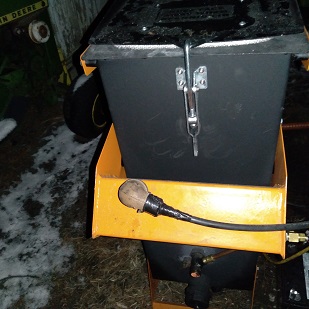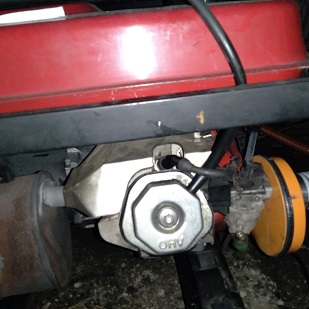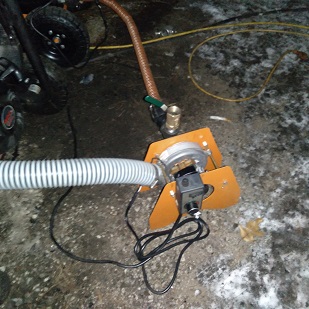Is this injector still feeding the water into the nozzle? With the pulse width modulation control wouldn’t you still need something like an automotive injector that opened and closed under pressure? Unless I’m misunderstanding this, pulsed water pressure before the needle valve would make it very difficult to meter the amount of water being fed during the pulse.
This is for a different more advanced system. It will have a pressure pump and electronic fuel injector that will spray infernally into the reactor core. The reactor is bell shaped and the internal heat flows thru the narrow portion of the bell. It will get extremely hot here well about 2000*. The idea is too spray on this area evenly to optimize steam production. The steam then migrates into the intake air stream. There will be temp probe in this area of the reactor to monitor temps and this input will control the PWM pulse of the injector. If it gets to cold it will spray less or even shut off. As it gets hot it will spray in more. if it gets too hot the controls will fault out.
Sorry for not clarifying even I have a hard time keeping up with myself lol
I’ve been thinking about something along these lines since I got back into this. I just don’t have your engineering and technological expertise. Very interested in seeing where this goes.
Don’t be confused by the word “pulse” in a PWM. It does not create a perceivable pulse in the output from the pump. The PWM pulses the DC at high frequency (1khz -200khz) so that the pump output is varied while maintaining the appropriate voltage for motor efficiency. The PWM gives a variable output that is very smooth.
Yeah current work load will suspend this development well into next year. So for now my focus is on the simpler M-Series. Kinda sucks as I have all these ideas flooding me pee brain and I want to build it. But systems this advanced require money and time. I have neither right now. However we are getting flooded with new orders coming in. I have not been this busy ever in the history of our existence. We went from flat line dead to crazyness. We will see if we can beat our high gross in 2021. Our highest gross income was 2013 with gross sales of just over $260k.
I run my fuel pumps on the four wire ones they work well, I can run the pump at any rate for any length of time, and it doesn’t get hot, but I prefer it to be off.
. 

@JocundJake , can you draw a sketch of how you connected your PWM, wondering if you pulled a new ground wire to the pump?
Ok I think I solved this issue with a very simple means. I simply tapped into the crank case vent of the engine and fed to the cap of the water tank. Flow is constant.
Another success I think that is not related to this topic is I built the Amteck blower super charger. Im not certain I am getting any more power; however, consistency is now quite amazing and I guess this does sort of relate to the water drip as well. I am not dripping water into this thing I am PORRING it in the machine!!. I only ran about 1/3 hopper and it fully consumed 2 liters of water in the tank. So yeah Might need to make the tanks much larger. I did not keep track of my time, but I think I had close to around 45 minutes. 1/3 hopper is less than five gallons of fuel and it was loaded. It is probably closer to 3 gallons of fuel it consumed.
I did try welding and at first I was nearly able to pull on that generator like it was running on gasoline. But then something happens where it just isnt as powerful. However, even at the lower power it is still slightly more power than with out it. Maybe laws of thermal dynamics kicking in. So that blower is probably consuming around 400 to 600 watts of power. So an actual turbo we may achieve this power. 500 watts is a pretty big gain on a small generator like this. But the biggest advantage is I think it is running more efficient at cracking the water as the blower dont care about load and is blowing a consistent flow into the engine. So higher and more consistent water cracking, the generator ran smoooooooth as well.
All this is just my initial thoughts and writing after only one attempt in the dark. So things Im sure will change as I learn more.



1 ltr of water converted to H2 comes to around 46.97 cubic feet. Best source I could find is H2 carries around 319 btu per cubic foot. So this gets us to slightly under 15,000 btu from one litre of water.
I dont know the CO conversion yet could not find data.
So 2 liters of water is around 30,000 btu added to a third of a hopper load. So full hopper I might be possible to convert 90,000 btu if all is actually be converted. If not that water is going somewhere and could be converting in the engine combustion process. So not a big loss if some is not fully converting.
One pound of charcoal is 9600 btu. I don’t have a weight on 10 gallons of charcoal so I can only guess. I would say around 20 lbs and this is not going to be linear anyways. So using this guestimate, it comes to around 192,000 btu.
Now add in the H2 this brings us to 282,000 btu.
Now I know the chip machines that were lab tested were roughly 300,000 btu.
As far as Im concerned charcoal wins as it only takes me a fraction of the time to produce the fuel to achieve this compared to direct chip fuels. That little bit of difference does not come close to outweighing the simpler construction, the run consistency, ease of use, less labor to produce fuel, plus I get heat from it and more.
Edit and this is not even factoring in the CO production of the water drip. So it may even out with that added. I wish I had the time and assets to do precise test on this. Maybe next year when its warmer and the sun isnt going down at 3 pm.
I think I found the issue with lost power on that first try. Didnt think to dig for clinkers, found a soft ball sized nail clinker in there.
So re started for my nightly battery top off. Started at 11:15, Im trying to be more reserved on the water drip as I want it to go farther along with the hopper. Generally we get around a 1 hour run time. We will see how long she goes before I run out of water or fuel which ever comes first.
My air metering mixer valve is also about 50% more open than without the blower cramming in the goodies.
Oh yeah and the governor is at half its travel verses nearly wide open throttle plate. So I can turn up that governor yet to get more power. See always more to learn.
Update: I shut her down at 12:23 consumed the full hopper and around 2.5 ltrs of water. This is about on par as before. So no real gain on this run other than it ran solid the entire run. That it did not do before, but that could be in part with inconsistent water drip that is now solved. So more testing and learning. Ill increase the water drip on next runs and see if I can get more out of a hopper load.
I don’t remember wire colors. On dodge Dakotas the power and the ground for the fuel pump all runs to the fuse box. So I cut both of them, ran four wires into the cab, one ground in and ground to the pump and one power in and one power to the pump. the PWM was marked with power and ground in and power and ground out .
Hope that makes sense, I cant upload pics right now, sorry.
Thanks Jakob, will look at what it looks like on mine, but think the pump is grounded in the chassis.
This is barely related to your blower supercharger post. This video just shows a car they built on RoadKill using 5 leaf blowers as forced induction. This is just a blurb video. The video from the show is on the list at the right. Roadkill is the best show on TV for idiots like me.
Hi Jan,
If you study the Kalle design/ physics behind it you will come to the conclusion that water is more effective than returned exhaust gas.
The reason is the dilution with "useless"nitrogen…
H2O will reduce your glow in the charcoal AND provide you with energy in return…
Many things can be done at/with/in that particular process
Key point would be to study the costs and benefits of doing it the proper way.
Best way is to use any kinda waste heat from your engine, any hot surface, to turn the water into steam and subsequential suck it into the nozzle…
The heat transfer from nozzle tip to the outer shell of the gasifier is an excellent source of heat to put at use for the waterdrip to steam.
Just keep in mind what makes the gas: heat and carbon, balanced exothermic and endothermic reactions…
Thanks for the explanation Koen.
Yeah I may try to plug into the house AC and see if I can get those watts to run that blower back. If I can get more power this way then the next steps will be to install the little turbo I have. Ive had this turbo for years, but was afraid the direct raw fuels gasifiers would destroy it. Now working with charcoal that is no longer an issue.
If I unplug everything from the generator other than the primary power out to the shop. I can run the CNC plasma cut table on a direct raw fuels gasifier, this is any of the machines Ive produced, chips or pellet fuels and this is (marginally). This means even the air compressor to supply the air is off. So I have to make the cut and when air gets low I have to stop recharge the air compressor and then continue.
So I still need to attempt this on chargas with water injection yet.
I guess my problem is that I understand how most fuels work in an IC engine but find wood gas to be in many ways counter intuitive. I think that in the other thread where you said that you weren’t making a gasifier but a water cracking devise or something along those lines, that you were addressing the fact that it doesn’t seem possible to concentrate the gas itself so any kind of boost is upsetting the gas/air ratio and is counter productive. Being new to all this I’m finding it hard to navigate the learning curve. Pretty interested in the things you are doing. I hope someday to understand them.
Ok had a good run tonight. I plugged into the house AC, this is still coming from the generator as it is charging the bank and the bank is supplying power to inverter. This just for a test.
So the charger was struggling to keep up however there was a net gain putting power into the bank.
While I was charging I ran the E- Chain saw to process the drops from a wood mill on the property here for tomorrows wood heat and charcoal production. This is the strongest I have ever seen the generator run on wood to process wood running this chainsaw. It cut just like that generator was running on gasoline. I then moved over to my 220 MIller welder to run some beads at my normal settings. It ran that welder also as well as on gasoline. Not even the direct raw fuels machines can do this. I am certain I am getting more power out this unit than I would with the raw fuels machines.
However, I also turned off that blower and no change. It is the water drip that is now running consistent now that the the tank has some pressure in it. I then tried to run the blower plugs into the generator directly and I could not achieve a consistent bead with the same settings. So unplugged it and tried again with that same result. The fuel was getting down and the generator was starting to struggle. So need to re attempt this test with a full hopper and the system running strong again.
I may hold off on this super charger for a bit and re learn the machine naturally asperated. There are too many changes, so need to step back and get an idea of how this thing runs now that the water drip is fixed. Once I get new run time and power data running the various machines in the shop. Ill then re set up the super charger and evaluate the same way.
Ill create a new thread for turbo / super charging charcoal and keep this thread for its main purpose of refining the water drip systems.
Hi Matt,
Its great to see you making these progresses, keep it up…
Now bear in mind, a raw wood gasifier is actually a charcoal gasifier with a condensate drip…
If you do it right, then perfect gas…
If you push the limit with injecting anything into the “hot zone” you will notice the increase or decrease of quality gas.
You reached one goal already: no more ( destructive) tar in your engines
and now you are learning the power curve you can achieve…
Welcome in the world of learning and achieving ( by doing and observing )
Wish you a fruitful continuation for next years to come… 
Yeah me too!! haha…
Alls I can say is dont buy those that dismiss charcoal… I spent nearly 10 years developing direct raw fueled machines with hundreds of thousands of dollars into it. I guess everything happens for a reason, as I have advanced knowledge of the combustion processes, physics of the internal workings and developed very advanced automation systems to self sustain hands free operation of a raw fueled gasifier. So all that applied to charcoal now will allow me to advance this technology along with furthering the development of fuel production and combining it with CHP. For a CHP system; Charcoal is the way as you are not going to want to run a gasifier around the clock for heat or hot water. Charcoal you can do that producing your fuels and then get power from the charcoal creation with much less efforts and at way less cost and complexity. My fuel mixer system I can build very cheap, my automation systems have come a long long ways and are very solid today.
